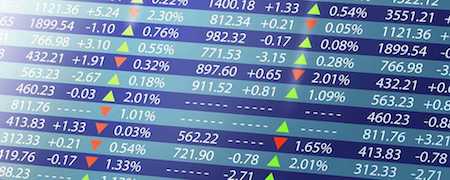Mid Term

April 30, 2021 | Daily JAM, Mid Term |
The value of all domestically produced goods and services has almost recovered to the pre-pandemic high recorded by the fourth quarter of 2019 of an inflation adjusted annualized $19.3 trillion but the U.S. stock market has raced well ahead of that recovery. The Standard and Poor’s 500 is up 29.3% from the end of 2019 to the close on April 29.

April 29, 2021 | AAPL, Daily JAM, Mid Term, Morning Briefing, You Might Have Missed |
After the close yesterday, April 29, Skyworks Solutions (SWKS), a key Apple supplier and a maker of radio frequency chips for smartphones and WiFi networking equipment, reported earnings of $2.37 a share on sales of $1.17 billion for quarter that closed on April 2 2021. That beat–slightly–Wall Street projections for earnings of $2.35 a share and sales of $1.15 billion. Year over year Skyworks earnings climbed 77% and sales rose by 53%. And what happened to the stock in after-hours trading? It got punished. Shares dropped to $183.37, a loss of $14.49 a share from the day’s close at $197.86. That’s a loss of 7.32%. In a market driven by expectations for constantly higher growth, I think you can see the problem.

April 16, 2021 | Daily JAM, Mid Term |
China’s Bureau of Statistics reported that the country’s gross domestic product climbed 18.3% in the first quarter from the first quarter of 2020. Economists surveyed by Bloomberg had projected 18.5% year over year growth.

April 15, 2021 | Daily JAM, Mid Term |
Retail sales rose a stunning 9.8% in March from February’s pace, the Commerce Department reported today, April 15. In the earlier month retail sales fell 2.7%.

April 12, 2021 | Daily JAM, Dip-O-Meter, Mid Term, PYPL, RUN, TDOC, Volatility |
Looking at the recent performance numbers on the 20 stocks I’m tracking in my Dip-O-Meter as of the close on Friday April 9, I have to conclude that for most of these stocks it’s time to take a pause on any “buy on the dip” opportunities. What I’m seeing in this sample is a general weakening of the upward bounce on rally days from these stocks–and without a strong bounce on a good day there’s not much reason to buy on the dip.

April 10, 2021 | Daily JAM, Mid Term, You Might Have Missed |
The week ahead could well bring even less volatility and even more complacency as we move into what everyone expects to be a stellar earnings season–at least in comparison to the first quarter of 2020

April 7, 2021 | Daily JAM, Mid Term, Morning Briefing |
Nothing to see here. Move along. In the minutes from its March 16-17 meeting, released today April 7, Federal Reserve officials told the financial markets “that it would likely be some time until substantial further progress toward the [Open Market] Committee’s maximum-employment and price-stability goals would be realized.” And, the minutes went on, “a number of participants highlighted the importance of the Committee clearly communicating its assessment of progress toward its longer-run goals well in advance of the time when it could be judged substantial enough to warrant a change in the pace of asset purchases.”

March 25, 2021 | Daily JAM, Mid Term |
Today’s auction of $62 billion in seven-year Treasury notes was a big improvement on the dismal February auction. But the 5- and 7-year heart of the yield curve is still showing stress as it tried to absorb huge amounts of issuance.

March 12, 2021 | Daily JAM, Friday Trick or Trend, Mid Term |
The iShares 20+ Year Treasury Bond ETF (TLT) fell 2.12% at the close today to drop into a Bear Market having lost more than 20% from its August high. That’s just in case you needed a reminder of how relentless the selling in the Treasury market has been. At the close at $136.06, the ETF is below the both the 50-day and 200-day moving average. And the Treasury bond ETF is down 13.74% year to date as of the close on March 12. Treasury bonds, even long-dated Treasury bonds aren’t supposed to produce that kind of volatility. Which leads me to the important question: How long does this rout go on and what are the odds of a short-term bounce?

February 17, 2021 | Daily JAM, Mid Term, Special Reports, You Might Have Missed |
2021 is shaping up as an especially challenging year for investors. Much, much more challenging than 2020. I don’t think we can count on this rally running uninterrupted through the year. That would be simple, wouldn’t it? We’d all know how to profit from that scenario. And I don’t think the market is about to drop off a cliff from its current record highs. That would be traumatic. But, still, we do know how to protect a portfolio in that scenario. And even how to profit from a prolonged plunge–if we can bring ourselves to place those short and Put Options bets. Instead 2021 is likely to be one of those years with a Rally Stage and then a correction (or “something”) to be followed by a last quarter of 2021 that is, at this moment, close to completely unpredictable. That would make 2021 one of those years that gives investors a chance to be wrong several times over, to botch timing on the upside and the downside, and to let emotions power some really bad investment moves. I don’t pretend that I’ve got this year’s market stages down perfectly–although I think the outlines for the first two stages for 2021 are pretty clear. I don’t imagine that I’ve got the timing for navigating these stages clocked perfectly–although I do think I understand “generally” when the market is likely to switch gears. And that lets me lay out for you a likely pattern for 2021 and to suggest stocks and ETFs to use to navigate this year. Part of the point in getting as specific as I can at this point isn’t that I expect that I’ve got everything right, but to lay out concrete markers that will let you and me adjust portfolios as the year progresses. I’m dividing this Special Report into three parts.

February 11, 2021 | Daily JAM, Mid Term, Morning Briefing |
In a speech on Wednesday, Federal Reserve chair Jerome H. Powell said that the unemployment rate in January was close to 10%, not the 6.3% rate reported by the Labor Department last week.

February 8, 2021 | Daily JAM, Mid Term, You Might Have Missed |
Stocks climbed for a sixth straight day–the longest string of gains for the Standard & Poor’s 500 since August and with the Dow Jones Industrial Average turning in its best start for a February since 1931. The S&P 500 finished the day ahead 0.34% and the Dow gained 0.76% on the session. The NASDAQ Composite was up 0.95% and the NASDAQ 100 added 0.67%. The biggest winner for the day was the small cap Russell 2000, which gained 2.53% on strength in bank stocks and hope for more growth in the general economy. Oh, and the hope for $1,400 checks to individual Americans, hundreds of billions of dollars in state and local aid and enhanced federal unemployment benefits. And continued progress on the Covid-19 vaccination program. All this means, in my opinion, that the currently stretched valuations in this stock market are likely to get even more stretched in the coming days and weeks.














